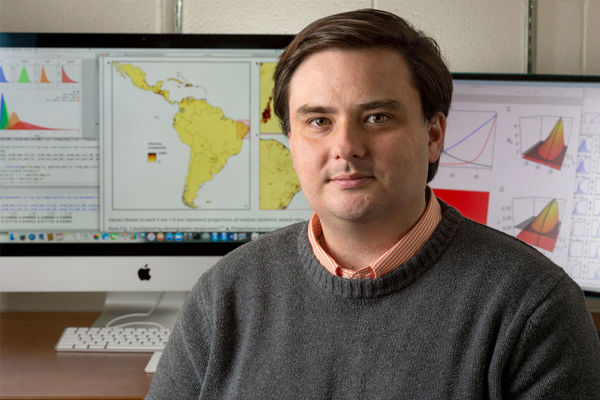A major outbreak of dengue fever in southern China in 2014 may have been caused by more than just high temperatures, numbers of mosquitoes, or imported cases from Southeast Asia. Despite previous studies that point to these specific reasons for the outbreak that affected almost 40,000 people, a new study from the University of Notre Dame shows there likely were other factors involved as well.

The study, published recently in Nature Communications, was conducted by Alex Perkins, Eck Family Assistant Professor in the Department of Biological Sciences, and collaborators including lead-author Rachel J. Oidtman, a fourth-year graduate student in the department, and other researchers in China and Europe. The team used a modeling technique that evaluated the role of not only known causes of dengue outbreaks, but also potential causes yet unknown to researchers.
Dengue fever is a virus transmitted by the Aedes genus of mosquito, which also transmits the yellow fever, Zika, and chikungunya viruses. Symptoms include fever, headache, nausea, rash, joint pain, and minor bleeding or bruising. Understanding the spread of dengue in China may lead to understanding of the disease in other areas that are not endemic for the virus, including parts of the southern United States, in the wake of rising temperatures.
“We’re not the first people who have studied this dengue outbreak in China, but we thought it might be worth taking a closer look at it with modeling techniques that we thought might shed some new light on this question of what drove such an unusually large outbreak that year,” said Perkins, who is affiliated with the Eck Institute for Global Health.
They looked at eleven years’ worth of data and determined that in years with far smaller outbreaks, there was at least one factor unfavorable for a major outbreak, whether it be temperature, low number of mosquitoes, or few imported cases. In 2014 “basically everything lined up just right, kind of like this perfect-storm phenomenon.” But the team had to allow for some statistical “noise” that they couldn’t quite explain in the model, which led them to realize other factors, that no one yet completely understands, played a big role in driving the outbreak.
These factors could include age of mosquitoes – older mosquitoes are more likely to transmit disease because of its incubation period – the serotype of the virus, or its “strain,” and the way the disease affects people upon first, second, or third infection. Up to 80 percent of people show no symptoms during their first infection, even though they may still pass it on to others, Oidtman said.
“One of the most significant things we learned from this is that it shows that even by using all the available data, we can’t necessarily draw a firm conclusion about what’s driving dengue dynamics in China,” she said. “There are complex, interacting factors that are all coming together, that also interact with chance, to lead to such a large outbreak.”
Perkins and Oidtman are planning a trip to China this summer to meet with their Chinese collaborators to make plans for future studies. “If we understand what drove these outbreaks better, then it will improve our ability to predict future outbreaks,” Perkins said.
In addition to Oidtman and Perkins, other collaborators include Amir Siraj, also of Notre Dame; Shengjie Lai, of Fudan University, Shanghai, China, as well as the University of Southampton, United Kingdom and the Flowminder Foundation of Stockholm, Sweden; Hongjie Yu and Juan Yang, both from Fudan University, and Andrew Tatem, of the University of Southampton and Flowminder Foundation. The research was funded in part by the Arthur J. Schmitt Leadership Fellowship in Science and Engineering, an Eck Institute for Global Health Graduate Fellowship, and a mini-grant from GLOBES, an Interdisciplinary Graduate Training Program in Environment and Society.
Originally published by at science.nd.edu on June 05, 2019.
